Maneless lion
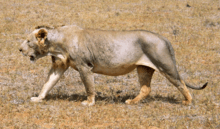
The term maneless lion often refers to a male lion without a mane, or with a weak one.[1][2] The main purpose of the mane is thought to protect the lion in territorial fights.[1] Although lions are known for their mane, not all males have one.[2]
Modern lions
In Eurasia
The Asiatic lion is often considered to have a weak mane compared to African lions, due to the hot climate in Asia,[4] but this does not always apply. The manes of most lions in ancient Greece and Asia Minor were also less developed and did not extend to below the belly, sides or ulnas. Lions with such smaller manes were also known in the Syrian region, Arabian peninsula and Egypt,[5] while in Gir Forest of India, cases of maneless lions are rarely reported.[6]
In Iran there are often pictures of stone reliefs with Asiatic lion without mane. In the 19th and 20th centuries (1916) lions were reported without mane.[7]
J. S. Buckingham related the story of being shown a small natural cavern, which a lion had made his den near Sar-e Pol, and of two young men who went out to kill the lion with the result that one of them was first killed himself (1829). Travelling from Shiraz to Kazerun, Buckingham noted:[7][8]
The herds were carefully watched by shepherds during the day, and were all driven into shelter before sunset, as lions were known to have their dens in the neighbourhood, and to prowl here at night, to the terror both of caravans and single passengers.[8]
In Africa
In sub-Saharan Africa, lions with weak manes were reported in Murchison Falls National Park, Uganda, and in 1944, maneless lions were reported in Botswana.[9]
Tsavo male lions generally do not have a mane, though colouration and thickness vary. There are several hypotheses as to the reasons. One is that mane development is closely tied to climate because its presence significantly reduces heat loss.[10] An alternative explanation is that manelessness is an adaptation to the thorny vegetation of the Tsavo area in which a mane might hinder hunting. Tsavo males may have heightened levels of testosterone, which could also explain their reputation for aggression.[10]
West African lions are often seen with weak manes or none.[11][12]
Lions in Ancient Egyptian art are usually depicted without a mane, but with a ruff around the neck.[13] The reason for this is not known.[1][14]
Prehistoric lions
Cave paintings from the Pleistocene epoch often depict lions without manes, even if with the scrotum.[16][14][17]
See also
- Barbary lion and Cape lion, two lions with the most luxuriant and extensive manes
- Central African lion
- History of lions in Europe
- Northeast African lion
- Tiger versus lion
References
- 1 2 3 Joubert, D. (1996). "Letters: By any other mane". New Scientist: 8. Retrieved 2018-01-22.
- 1 2 "What is a maneless lion?". "Dictionary" by Farlex.
- ↑ Sevruguin, A. (1880). "Men with live lion". National Museum of Ethnology in Leiden, The Netherlands; Stephen Arpee Collection. Retrieved 2018-03-26.
- ↑ Dr. Jackie; A. Baroluss. "The effects of the hot climate on the development of Asiatic lion's mane". Missing or empty
|url=(help) - ↑ Heptner, V. G.; Sludskii, A. A. (1992) [1972]. "Lion". Mlekopitajuščie Sovetskogo Soiuza. Moskva: Vysšaia Škola [Mammals of the Soviet Union, Volume II, Part 2]. Washington DC: Smithsonian Institution and the National Science Foundation. pp. 83–95. ISBN 978-90-04-08876-4.
- ↑ Asiatic lion: Asiatic lion's larg mane of males in Gujarat, India
- 1 2 D. T. Potts. "The maneless Asiatic lion (Panthera leo leo formerly P. l. persica) of southwestern Iran" (PDF).
- 1 2 "Full text of Buckingham". Internet Archive.
- ↑ Buckingham: The weak mane of Southern African lion (Panthera leo melanochaita). Retrieved 2018-08-22.
- 1 2 Call the Hair Club for Lions. The Field Museum.
- ↑ Schoe, M.; Sogbohossou, E. A.; Kaandorp, J.; De Iongh, H. (2010), "Progress Report – collaring operation Pendjari Lion Project, Benin", The Dutch Zoo Conservation Fund (for funding the prject)
- ↑ Trivedi, Bijal P. (2005). "Are Maneless Tsavo Lions Prone to Male Pattern Baldness?". The National Geographic. Retrieved 7 July 2007.
- ↑ Nagel, D., Hilsberg, S., Benesch, A., Scholtz, J. (2003). "Functional morphology and fur patterns in recent and fossil Panthera species". Scripta Geologica 126: 227–239.
- 1 2 "Lions of Ancient Egypt". The American Uiversity in Cairo Press.
- ↑ Chauvet, J.-M.; Brunel, D. E.; Hillaire, C. (1996). Dawn of Art: The Chauvet Cave. The oldest known paintings in the world. New York: Harry N. Abrams.
- ↑ Koenigswald, Wighart von (2002). Lebendige Eiszeit: Klima und Tierwelt im Wandel (in German). Stuttgart: Theiss. ISBN 978-3-8062-1734-6.
- ↑ Yamaguchi, Nobuyuki; Cooper, A.; Werdelin, L.; MacDonald, David W. (2004). "Evolution of the mane and group-living in the lion (Panthera leo): a review". Journal of Zoology. 263 (4): 329–342. Bibcode:2010JZoo..281..263G. doi:10.1017/S0952836904005242.
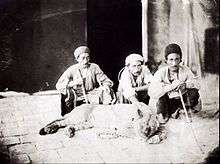
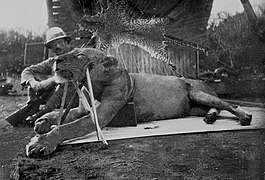
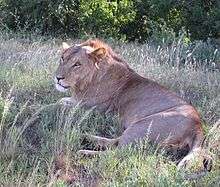
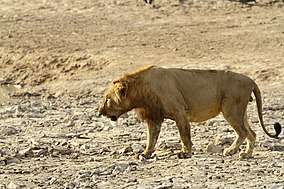
.jpg)